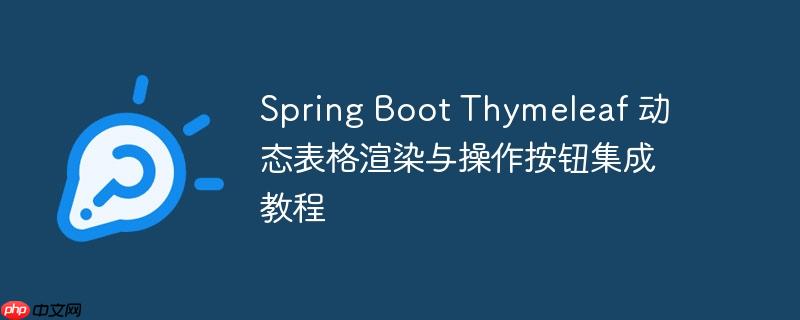
本教程旨在解决spring Boot应用中,使用thymeleaf模板引擎渲染动态表格时,如何正确地为每行数据添加操作按钮(如删除按钮)的问题。我们将通过构建一个包含数据模型、后端控制器和前端模板的完整示例,详细讲解如何避免常见的循环嵌套错误,确保每条记录对应一个操作按钮,从而实现清晰、功能完善的数据展示与交互。
引言
在Web应用开发中,动态展示列表数据并为每条数据提供交互功能(如编辑、删除)是常见需求。spring boot结合Thymeleaf提供了一种简洁高效的解决方案。然而,在实现过程中,开发者有时会遇到循环嵌套不当导致操作按钮重复生成的问题。本教程将深入探讨如何正确地使用Thymeleaf的th:each属性,实现每行数据对应一个操作按钮的动态表格。
问题分析:常见误区与原因
原始问题中,开发者尝试通过分别迭代descriptionList和idList来填充表格列,并在一个嵌套的th:each中为idList生成删除按钮。这种做法的问题在于:
- 数据分散: descriptionList和idList是两个独立列表,它们之间没有明确的关联,导致在表格行中无法将描述和ID正确地一一对应。
- 循环嵌套不当: 在
内部,对idList进行第二次th:each循环,会导致为每一行(由descriptionList生成)再次生成与idList数量相等的 元素,其中包含重复的按钮。 正确的做法是,将每行相关的数据封装成一个独立的Java对象,然后迭代这个对象列表。
解决方案:构建统一数据模型与单次迭代
为了解决上述问题,核心思想是将同一行的数据封装到一个Java对象中。这样,我们只需对这个对象列表进行一次迭代,即可访问每行的所有相关数据。
1. 定义数据模型
首先,创建一个Java类来表示表格中的每一行数据。例如,我们可以定义一个WishItem(或User,如原始答案所示)类,包含ID、描述(或邮箱)等属性。
// src/main/java/com/example/demo/model/WishItem.java package com.example.demo.model; public class WishItem { private Long id; private String description; // 或者 email // 其他可能需要的属性 public WishItem(Long id, String description) { this.id = id; this.description = description; } // Getters and Setters public Long getId() { return id; } public void setId(Long id) { this.id = id; } public String getdescription() { return description; } public void setDescription(String description) { this.description = description; } // 实际项目中可能还需要equals(), hashCode(), toString() }
2. Spring Controller 后端处理
在Spring Controller中,我们需要创建WishItem对象的列表,并将其添加到Model中,以便Thymeleaf模板可以访问。
// src/main/java/com/example/demo/controller/WishController.java package com.example.demo.controller; import com.example.demo.model.WishItem; import org.springframework.stereotype.Controller; import org.springframework.ui.Model; import org.springframework.web.bind.annotation.GetMapping; import org.springframework.web.bind.annotation.PostMapping; import org.springframework.web.bind.annotation.RequestParam; import java.util.ArrayList; import java.util.List; @Controller public class WishController { // 模拟数据存储 private List<WishItem> wishItems = new ArrayList<>(); public WishController() { // 初始化一些模拟数据 wishItems.add(new WishItem(1L, "购买新电脑")); wishItems.add(new WishItem(2L, "学习Spring Boot")); wishItems.add(new WishItem(3L, "旅行计划")); } @GetMapping("/wishlist") public String showWishList(Model model) { model.addAttribute("wishItems", wishItems); // 假设 email 是从用户会话或认证信息中获取 model.addAttribute("userEmail", "user@example.com"); return "wishlist"; // 返回 Thymeleaf 模板名称 } @PostMapping("/deletewish") public String deleteWish(@RequestParam("wish_id") Long wishId, @RequestParam("email") String email) { // 实际应用中需要验证 email 和 wishId 的关联性 wishItems.removeIf(item -> item.getId().equals(wishId)); System.out.println("删除愿望 ID: " + wishId + ", 用户邮箱: " + email); return "redirect:/wishlist"; // 重定向回列表页面 } }3. Thymeleaf 模板前端渲染
在Thymeleaf html模板中,使用th:each属性迭代wishItems列表。对于列表中的每一个WishItem对象,生成一个
,并在其内部访问WishItem的属性来填充 。 <!-- src/main/resources/templates/wishlist.html --> <!DOCTYPE html> <html lang="zh" xmlns:th="http://www.thymeleaf.org"> <head> <meta charset="UTF-8"> <title>我的愿望清单</title> <style> table { width: 80%; border-collapse: collapse; margin: 20px 0; } th, td { border: 1px solid #ddd; padding: 8px; text-align: left; } th { background-color: #f2f2f2; } button { padding: 5px 10px; background-color: #dc3545; color: white; border: none; border-radius: 4px; cursor: pointer; } button:hover { background-color: #c82333; } </style> </head> <body> <h1>我的愿望清单</h1> <table> <thead> <tr> <th>ID</th> <th>描述</th> <th>操作</th> </tr> </thead> <tbody> <!-- 使用 th:block 或直接在 tr 上循环 --> <th:block th:each="item : ${wishItems}"> <tr> <td th:text="${item.id}">1</td> <td th:text="${item.description}">购买新电脑</td> <td> <form th:action="@{/deletewish}" method="post"> <!-- 传递当前愿望的ID作为隐藏字段 --> <input type="hidden" name="wish_id" th:value="${item.id}"> <!-- 传递用户邮箱,如果需要 --> <input type="hidden" name="email" th:value="${userEmail}"> <button type="submit">删除</button> </form> </td> </tr> </th:block> </tbody> </table> <p>当前用户邮箱: <span th:text="${userEmail}">user@example.com</span></p> </body> </html>在上述Thymeleaf代码中:
- th:each=”item : ${wishItems}” 在
(或直接在
上)上进行迭代,item代表当前循环到的WishItem对象。 - th:text=”${item.id}” 和 th:text=”${item.description}” 分别显示当前WishItem的ID和描述。
- input type=”hidden” name=”wish_id” th:value=”${item.id}” 将当前WishItem的ID作为隐藏字段传递给表单,确保点击删除按钮时,后端能准确识别要删除哪条记录。
- input type=”hidden” name=”email” th:value=”${userEmail}” 同样传递用户邮箱,这在需要验证操作权限或记录操作者时非常有用。
注意事项与最佳实践
- 单一数据源: 始终将相关的行数据封装在一个对象中,并迭代这个对象的列表。避免在
内部进行多次独立的th:each循环。 - 数据模型设计: 良好的数据模型设计是基础。根据业务需求,合理定义Java对象的属性。
- 安全性: 在处理删除等敏感操作时,后端务必进行严格的权限验证和数据校验,确保用户只能操作其有权限的数据。例如,后端应验证传入的email是否与当前登录用户匹配,并且该用户确实拥有wish_id对应的愿望。
- 用户体验: 删除操作通常伴随确认提示(如JavaScript confirm()),以防止误操作。本教程侧重后端和模板,前端交互可进一步增强。
- restful API: 对于更复杂的应用,可以考虑使用RESTful API和JavaScript进行数据交互,而非传统的表单提交。但对于简单的数据展示和操作,Thymeleaf的表单提交方式依然高效。
总结
通过本教程,我们学习了如何在Spring Boot和Thymeleaf中正确地实现动态表格的渲染,并为每行数据添加独立的操作按钮。关键在于构建统一的数据模型,并在Thymeleaf模板中使用单次th:each循环迭代这个模型列表。这种方法不仅解决了按钮重复生成的问题,也使代码更加清晰、易于维护,是构建功能完善的Web应用的重要一步。
- th:each=”item : ${wishItems}” 在


评论(已关闭)
评论已关闭